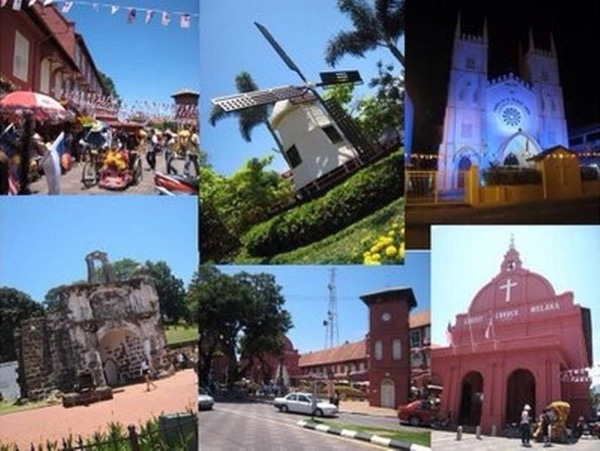Published: Friday June 27, 2014 MYT 12:00:00 AM
Updated: Friday June 27, 2014 MYT 10:34:03 AM
Updated: Friday June 27, 2014 MYT 10:34:03 AM
Malacca's first Chinatown

The back of most shophouses in Kampung Pantai are painted with colourful murals depicting scenes of Malacca.
|
|
THIS is one place where business has gone on as usual, from as early as the 17th Century.
Kampung Pantai, located along the west bank of the Malacca River has never ceased being a hectic trading hub.
It was Malacca’s original Chinatown during Dutch rule between 1641 and 1845 before the shophouses spread east across the river.
The choice was not by coincidence.
The river bank (pantai in Malay, or pantei as the Peranakan folk pronounce it), provided easy access for goods to be loaded into the godowns at the back of the shophouses.
The word, godown, by the way, can be traced to the Malay word gudang and earlier to the Tamil kitangu or gadangu in Kannada, both of which mean store or warehouse.
Most of the early merchants, from the provinces of Fujian and Guangdong, and the island of Hainan imported rice, flour, salt, preserved vegetables, textiles, traditional medicines and Chinese wine.

A view of the Malacca River and pedestrian walkway behind the street.
Kampung Pantai’s business ties to mainland China is arguably the oldest in the country.
Even during the Communist insurgency and after independence when restrictions were placed on business links with China, traders here continued to import goods from the country as usual, thanks to the roles played by local Chinese associations and guilds.
By the early 1920s, Kampung Pantai was so chock-a-block with shophouses, and hawker stalls that the then Crown Colony’s resident councillor closed it to motorised traffic.
Not that there were that many cars then, save for the occasional Wolseley, Humber, Maxwell or Nash.
Most people moved about on horse carts called gharries, bullock carts or rode on rickshaws.

Hwee Hean, whose grandfather started the Koh Beng Huat teashop, packing tea into smaller packs.
But the early types of buses, called charabanc — featuring seven rows of seats, canopy tops, luggage rails and roll-up side curtains — were already in service in Malacca.
By 1912, there were seven such vehicles — three Dennis, two Belhaven and a Daimler and an Albion.
Motor traffic was allowed to re-enter the street in 1925, after more than 70 Chinese shopkeepers sent an appeal to the councillors, stating that their businesses had been badly affected by the barring.
But the street remained the most congested and also most densely populated up to the late 1930’s, so much so that it was described as a “town planner’s nightmare”.
Not much has changed since then.
It is still crammed, no thanks to the continuous number of trucks loading and unloading goods along the street.
It is also one of the few places left where the tricycle cart is still used to move goods for short distances.

A wholesale shop worker sorting freshly arrived dates.
Many of the old shophouses, built in the 1920s and 1930s, still stand today with businesses that can be traced to between three or four generations.
This is where you can buy a mind boggling array of things — from rattan and bamboo goods, lion dance paraphernalia, traditional Chinese gift baskets, second-hand books, lanterns in all shapes and sizes, fruits — fresh, dried or pickled, Chinese wine and tea.
The most famous tea shop on the road is Koh Beng Huat, which offers a wide variety of teas from China and from elsewhere in Asia.
The third generation descendants of founder Koh Beng Jin, runs the business today.
Visitors are likely to see Beng Jin’s friendly granddaughter Koh Hwee Hean, keeping herself busy by packing tea into smaller packets in the middle of the narrow shop lined with teaboxes.
Like in most nearby streets, many of the pre-war shophouses have now been converted into budget hotels and backpacker lodges but Kampung Pantai is also famous for its old coffeeshops and food stalls.
Among the popular eateries include Long Fatt which serves traditional Teochew porridge accompanied by scrumptious side dishes.
The assam fish is the favourite of friends who frequent the place.
Among the things that make Kampung Pantai a fascinating place is the two contrasting views it offers to visitors.
While the front is a bustling business hub, the riverside of the street provides beautiful sights and serenity.
The back walls of the former godowns are now painted with colourful and dramatic murals, making this the loveliest stretch for those taking a boat ride on the river.
This is the place where tourists taking the 5km-long Malacca river cruise, take most of their pictures during the 45-minute ride.
The cruise has become a popular tourist attraction.
Last year, it recorded 1.2 million passengers, generating revenue of RM8.1mil for the state.
